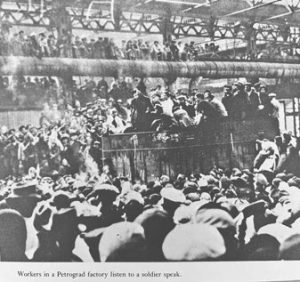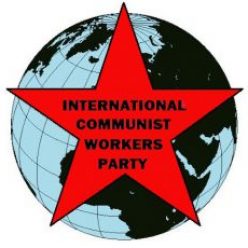Communists Learn that Military Revolts are Key to Revolution here ♦ The Communist International on Tactics during Imperialist War here ♦

Soldier speaks in Petrograd factory
The previous article (available here) explained lessons learned during the 1905 Potemkin mutiny, when many Tsarist military forces came over to the side of revolution. However, the Bolsheviks didn’t establish a party military organization. They submitted to a coalition dominated by capitalist collaborators. The party learned from their mistakes and built a military organization that made possible the socialist revolution of November 1917.
Communists Learn that Military Revolts are Key to Revolution
Mutiny in Andrei, Pavel, and Slava. Admiral Nebol’sin killed. Baltic Fleet does not exist as a fighting force. Will do what I can. —Vice-Admiral Nepinin, 3 March 1917
The Vice-Admiral couldn’t do much. Baltic Fleet sailors sunk the Tsar in February. Nine months later they helped overthrow the capitalist government that replaced him. The Vice-Admiral couldn’t even save his own neck; a revolutionary sailor shot him.
In February 1917, the Bolsheviks (Russian communists) had about 100 politically experienced veteran sailors within the tsarist Navy, including the defendants of the 1916 mutiny trials. These veteran revolutionaries were greatly esteemed. To augment Naval organizing, the party sent experienced organizers to live in base towns.
The Bolshevik press reached the Baltic Fleet quickly. The first newspaper was the Kronstradt Voice of Truth, which came out on March 15, quickly followed by the Helsinki Wave. The party guaranteed these papers were circulated even before other party papers reached important towns like Odessa, Baku, and Minsk.
The party also waged campaigns among soldiers in the front lines of World War I, Petrograd garrison soldiers, and other Red Guard detachments of mostly industrial workers. From February to November these key forces turned toward revolution.
Older Bolshevik sailors, soldiers and cadre fought to spread the lessons learned from the 1905 Potemkin mutiny to the hundreds of thousands recruited to the party during these six months. Party membership requirements were suspended to enroll masses as quickly as possible.
Bolshevik Military Organization Turns the Tide
On April 13, the party held the founding convention of the Bolshevik Military Organization (BMO) in Petrograd. It began publishing Soldier’s Truth. The Bolsheviks were the only ones among all Russian political parties to publish a military newspaper of national importance.
The BMO, relatively small at first, grew rapidly across Russia. As with sailors, the Bolshevik work among soldiers included veterans of previous military revolts. The BMO and these politically skilled veterans established the foundation for growth and revolutionary success.
By June, two thousand Petrograd garrison soldiers had joined the BMO. New military party organizations sprang up around the country.
The All-Russian Conference of Bolshevik BMOs met in Petrograd on June 17. One hundred and fifty delegates attended from forty-three front and seventeen rear military organizations. They represented about 30,000 soldiers and sailors.
Comrade Iurevich represented the party military organization among the Latvian Rifle Regiments. He reported that the Bolshevik collective numbered 1537 members, about 10% of whom were older, experienced revolutionaries. He claimed the Bolsheviks essentially controlled the Latvian Rifle Regiments.
In Petrograd, the Soviet leadership, still in the hands of the fake revolutionaries, called for a peaceful demonstration on June 30. The Bolsheviks showed their strength among workers and garrison troops: 400,000 marchers paraded under Bolshevik banners, including almost every garrison unit. The Menshevik (liberal capitalist) Sukhanov was alarmed:
“Here and there,” worried Sukhanov, “ the chain of Bolshevik flags and columns was interrupted by official Soviet slogans. But they were submerged in the mass [of Bolshevik socialist revolutionary propaganda].”
The Bolsheviks’ growing influence among soldiers, sailors and industrial workers enabled them to break loose from the coalitions that made up the Soviets. Ultimately, the only debate that mattered was inside the Bolshevik party over when to launch the armed insurrection. On November 7 they led key forces of the proletariat to seize power, changing the course of history.
Communist Tactics In The Bosses’ Armed Forces Spread Around The World
Fourteen imperialist countries invaded Russia. They aimed to “kill the baby in its cradle” by destroying the new revolutionary socialist government.
The Bolshevik foreign language press kept the invading frontline troops informed of the growing rebellions in their ranks. One such paper, The Call, found its way into unexpected places behind the British and American lines.
Red soldiers fraternized with rank-and-file soldiers of all the invading armies. Fraternization proved to be a potent military weapon.
The rebellions grew. Twenty thousand British soldiers revolted in the Calais (France) area, right across the English Channel. Prime Minister Lloyd George was alarmed: “If a military enterprise were continued against the Bolsheviki… there would be a Soviet in London.”
Troops in all fourteen of the invading armies revolted. After massive uprisings, all the bourgeois armies were forced to withdraw.
Lessons learned from the Potemkin mutiny built the foundation of a new Red Army among the soldiers and sailors in the Tsarist military thirteen years later. In turn, the Bolshevik revolution taught the worldwide communist movement to reject passive resistance among the troops in favor a building a communist base in the bosses’ armed forces.
Next: The Bolsheviks focused on recruiting the proletarian forces needed for revolution. But they fell victim to perhaps the most dangerous of reforms: socialism. Communists must learn the invaluable lesson: this time we’ll fight directly for communism.
Sources: Mawdsley, The Russian Revolution and the Baltic Fleet; Saul, Sailors in Revolt; White, The Growth of the Red Army; Rabinowitch, The Bolsheviks Come To Power.
The Communist International on Tactics during Imperialist War
The Congress of the Third International (the Communist International Movement of the 1920s and ‘30s) spelled out the tactics communists should use in imperialist wars:
When the question of joining the bourgeois army or refusal of military service (boycott) is raised, the Communists must advise the workers and poor peasants to reject the refusal of military slogan…to avail themselves at the proper moment, to turn their weapons against the bourgeois.
In the event of a big mass movement at the moment of the outbreak of war in favor of refusing military service, the communists must combat the boycott ideology and the pacifist boycott slogan. They must speak quite frankly and make it clear to the masses that the only correct way of combatting the imperialist war is to turn it into a civil war. Strenuous propaganda must be conducted urging the necessity of carrying on revolutionary work in the bourgeois armies.
Read the ICWP Pamphlet:
“Soldiers, Sailors, Marines: Crucial to a Communist Workers’ Revolution”

